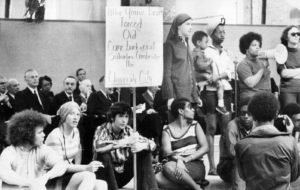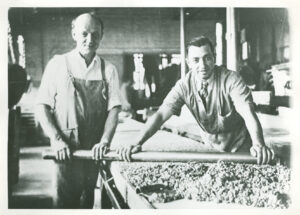
Industrial Age Cambridge supported bicycling, but with the genders and races together? Egads!
Above image: Cambridge cyclist and activist Katherine “Kittie” Knox, circa 1895. (Photo: Cambridge Black History Project)
By Beth Folsom
It seems there’s always been reasons for bicycling to be controversial in Cambridge, starting in the late 19th century when cycling gained tremendous popularity in Cambridge – and the nation as a whole – as a form of exercise and opportunity for social connection.
“Coaching has become tiresome, fox hunting has died a natural death, and the fashionable world is put to its wit’s end to devise something new wherewith to amuse itself. A summer rural tour of a cycling party, made up of both sexes, would be charming,” declared a Cambridge Chronicle article in May 1886.
In April 1887, the Cambridge Tribune debuted a “Cycling Notes” column that ran weekly during the spring, summer and fall months and reported on the doings of the various cycling clubs in and around Cambridge. (Yet the Tribune noted in February 1904 that “Washington’s Birthday has been the regular date for the local bicycle dealers to hold their annual ‘openings’ and start off the new wheeling season.” This tradition is borne out in the many advertisements in Cambridge newspapers that invite the public to attend the seasonal openings of local bicycle shops on Feb. 22.)
The clash at the time was gendered and racialized.
The early years of the cycling craze saw many opinions on the suitability of bicycle riding for women in terms of health and propriety. The end of the 19th century saw a rise in the popularity of physical exercise and time spent outdoors; Americans of the Gilded Age feared that the rise of industrialization and urbanization had made people weak, lazy and unhealthy, and argued that physical activity – especially outside – was the prescription for a heartier, more resilient population.
This was true for women as well as men, as a reporter for the Chronicle opined in 1894: “She is light, rugged and ruddy. She walks with a swing. She is wholesome and well groomed. She carries herself gracefully and proudly. The day of the thin, scrawny, awkward, hysterical young woman who trips along as if she were treading on eggs, or who runs on a hen canter, or wobbles, staggers, or struts, is over … Athletics have come to be a vital factor in the education and accomplishments of the fashionable girl.”
But while popular culture promoted physical exercise for girls and women, there were still many conscriptions around when, where and how they should engage in activities such as cycling. In an 1893 interview with the Chronicle, the president of the Woodbridge Bicycle Club – a Boston-based cycling club for women – explained that the club was “organized for the promotion and elevation of cycling for women … One reason why public sentiment is so strong against [women cycling] is that women have joined with the men so much, and that is why we intend to be exclusive to a great extent, and why we favor being entirely independent from the men and their cycle organizations.”
Even when women and men cycled together, they were bound by different expectations. In 1896, the Cambridge Tribune published a list of rules for mixed cycling parties focused largely on the responsibilities that men had to ensure the safety and comfort of the women in their party. And even those in the medical community who supported women cycling recommended that women should not “try to keep up the pace with men,” and that “stooping in riding ought not to be countenanced for a moment in women” (Cambridge Chronicle, March 30, 1895).
The issue of what women should wear while riding a bicycle was also debated hotly, with many people – mostly men, but some women as well – arguing that the custom of wearing bloomers was unseemly and immodest.
Young women were determined to dress in a way that allowed them to cycle comfortably, however.
A Tribune article of August 1895, reported on the trend of young men pledging not to associate with women who wore cycling costumes. In the end, the Tribune reported, “the young women prize their liberties far more than such friends, and stoutly refuse to be compelled to abandon a costume which they regard as eminently proper and becoming. These super-sensitive young men declare that they cannot tolerate the ‘new woman.’”
It is important to note that, despite the increasing popularity of bicycles and cycling clubs for men and women in the late 19th century, almost all of these organizations were off-limits to Black cyclists. In light of racial segregation, Black bicycle enthusiasts formed their own clubs, the most notable local example of which was the Riverside Cycling Club, based in Boston but open to residents of surrounding cities and towns.
Perhaps the best-known member of the Riverside Club was Cambridge’s own Katherine “Kittie” Knox, a young Black cyclist who refused to be bound by the conventional rules imposed on Black and female riders. Born in 1874, Knox spent much of her childhood in Cambridge before her family moved to Boston in the 1880s. An athletic and accomplished cyclist, Knox was also famous for riding a men’s bicycle and creating her own cycling costumes better suited to the practicalities of cycling. In 1893, she joined the overwhelmingly male League of American Wheelmen and publicly challenged the group’s 1894 decision to bar Black cyclists from joining the club. While ultimately unsuccessful in her attempts to change the policy, Knox’s challenge drew nationwide attention to the issue and helped to spark a public debate. (For more on Knox’s life and legacy, read the Cambridge Black History Project’s profile of this Black Trailblazer.)
The late 19th century’s advances in the popularity of cycling weren’t fully open to all enthusiasts. Members of marginalized groups managed to carve out spaces for themselves within the cycling world, though, and their challenges to gendered and racialized notions of bicycling would lead eventually to the breaking down of these borders in the sport.






